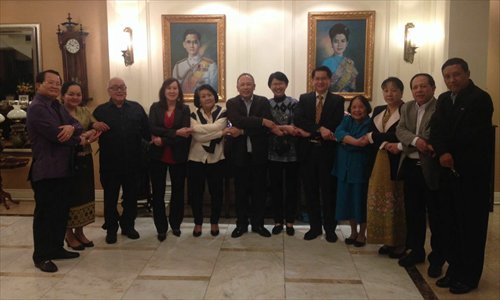ASEAN builds a community, enhances regional cooperation

Thai Ambassador Theerakun Niyom joins several ambassadors of ASEAN member countries and their spouses at the Thai Ambassador's Residence. Photo: Courtesy of Thai Embassy
Leaders from five Southeast Asian nations, Indonesia, Malaysia, the Philippines, Singapore and Thailand, met in Thailand on August 8, 1967, and, motivated by a shared vision to unite the countries of Southeast Asia in the common pursuit of peace, harmony and prosperity in the region, signed the Bangkok Declaration, establishing the Association of Southeast Asian Nations or ASEAN. Thus, August 8 is regarded by member countries as "ASEAN Day."
Today, ASEAN is a community of ten members (Brunei, Cambodia, Indonesia, Laos, Malaysia, Myanmar, the Philippines, Singapore, Thailand, and Vietnam) with a combined population of over 600 million and a combined nominal GDP of approximately $2.6 trillion. Each of the member countries have their own unique identities, yet share a common destiny of creating a more integrated, prosperous, compassionate, and effective ASEAN Community for the well-being of the people of ASEAN and beyond.
Since its inception, ASEAN has developed into a leading regional organization, committed to accelerating economic growth in the region, promoting regional peace and stability, enhancing regional cooperation in all areas, and fostering people-to-people contact, while playing a pivotal role in the international arena.
The ASEAN Community
The ASEAN Community is comprised of three pillars, the "political-security community," the "economic community" and the "socio-cultural community." Each pillar has its own blueprint and together they form the Roadmap for an ASEAN Community 2009-2015, which strives to build a people-centered, rules-based, cohesive and inclusive ASEAN Community, promoting connectivity in all dimensions and ASEAN centrality in the regional architecture.
This year is a special year for ASEAN, especially in the areas of community-building and economic integration, as the ASEAN Community and ASEAN Economic Community will be officially formed by the end of 2015.
ASEAN-China relations
ASEAN and China are close neighbors, good friends, and active partners. Since the commencement of their dialogue partnership in 1991 and the establishment of their strategic partnership in 2003, their relations have strengthened and their cooperation has deepened.
On the political-security front, China was the first dialogue partner to ratify the Treaty of Amity and Cooperation in Southeast Asia or TAC. China is also the first country among nuclear weapon states that expresses its readiness to sign the Protocol to the Southeast Asian Nuclear-Weapon-Free Zone Treaty of SEANWFZ.
Economically, in the coming years, much emphasis will be placed on enhancing connectivity and furthering economic integration by upgrading the ASEAN-China Free Trade Agreement (ACFTA) by 2015. To date, China is ASEAN's largest trading partner, with bilateral trade reaching approximately $480 billion in 2014, an increase by 8.3 percent from 2013. The ASEAN-China investment volume was $12.18 billion in 2014. Bilateral trade is expected to reach approximately $500 billion in 2015 and $1 trillion by 2020.
In 2014, 11.4 million Chinese visited ASEAN member countries, and 6.2 million people from ASEAN visited China. These numbers reflect the close ties between ASEAN and China at the people-to-people level.
In terms of connectivity, ASEAN welcomes China's support as ASEAN strives towards regional connectivity, which is consistent with China's "One Belt, One Road" initiative, which envisions infrastructure development and transport connectivity as a way to bring participating countries closer together, facilitating better access for trade, investment, tourism and people-to-people exchanges. Thailand, with its strategic location, can play a key role in linking the region.
Furthermore, the China-ASEAN Expo (CAEXPO) and the China-ASEAN Business and Investment Summit (CABIS) in Nanning, Guangxi Zhuang Autonomous Region, has provided an important platform for ASEAN and China to enhance mutual trust, expand business opportunities, and advance all-round exchanges. At the 12th CAEXPO in September this year, Thailand will be the country of honor.
In terms of socio-cultural cooperation, ASEAN and China designated 2014 as the "ASEAN-China Cultural Exchange Year." Throughout the year, various activities were organized which helped enhance mutual understanding and friendship. ASEAN and China will continue to strengthen people-to-people contact as well as education and cultural exchanges and are preparing a new Plan of Action (2016-2020) which is scheduled for adoption at the 18th ASEAN-China Summit in November.
Between 2012 and 2015, Thailand served as country coordinator for ASEAN-China relations, where it emphasized the "3 Cs" strategy - community building, connectivity, and code of conduct - to engage China. Thailand has played an active and constructive role in building confidence and creating an environment conducive for further development of ASEAN-China relations.
As 2016 will mark the 25th Anniversary of ASEAN-China Dialogue Relations and as ASEAN becomes a Community by the end of 2015, it will serve as opportune time for ASEAN and China to strengthen its partnership and cooperation. It is an anchor for regional peace, stability and prosperity in the region.
The author is the Thai Ambassador to China.